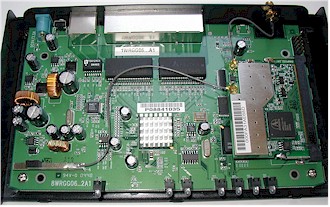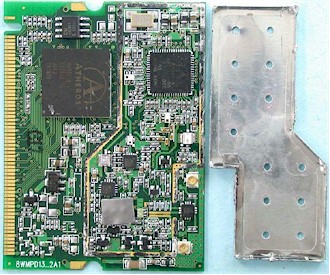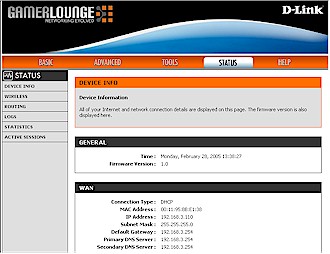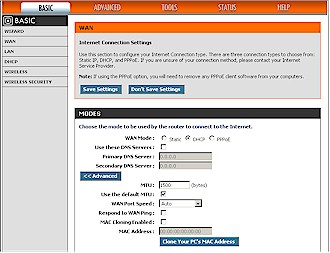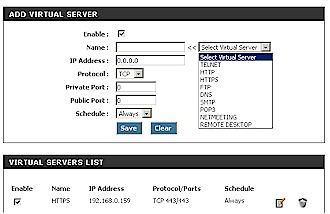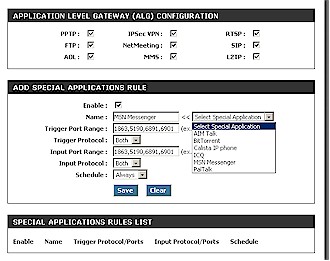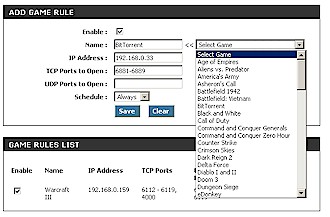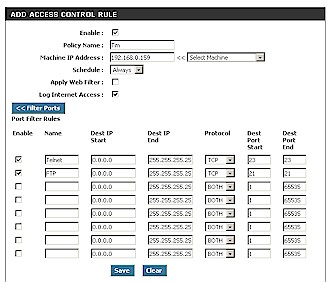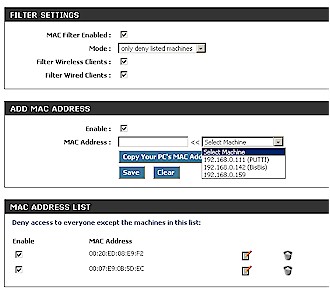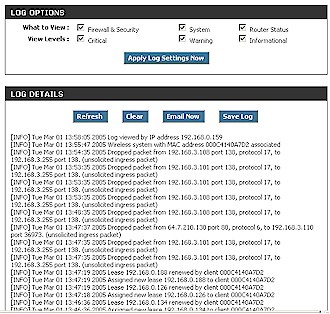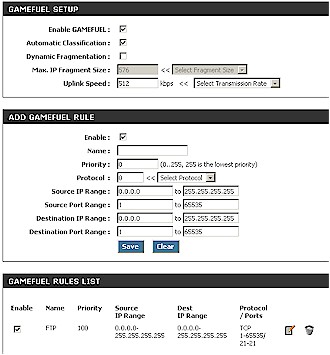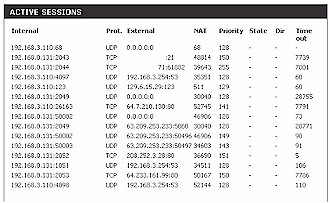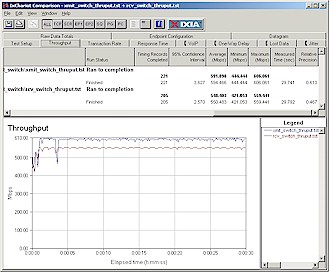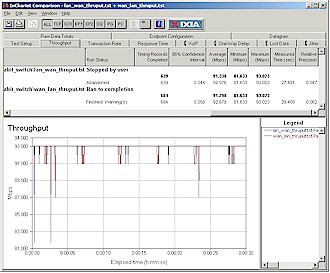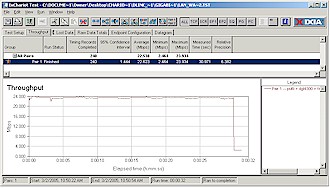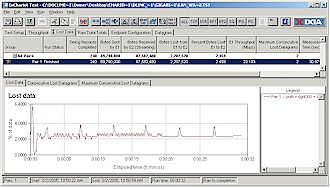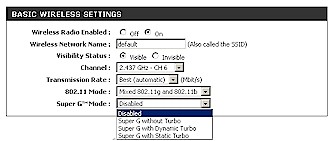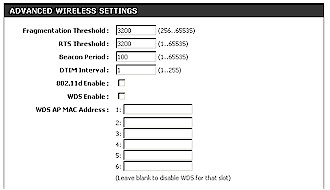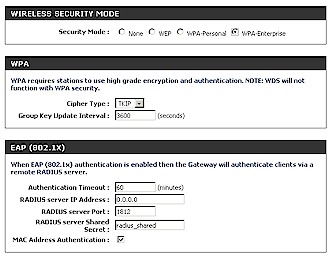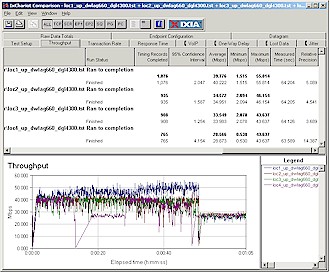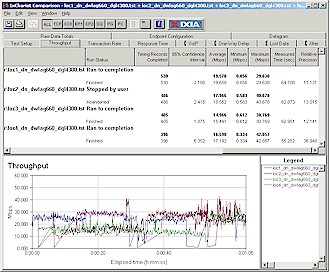Introduction
| D-Link Wireless 108G Gaming Router | |
|---|---|
| Summary | Wireless router with 4 port Gigabit Ethernet switch and Atheros Super-G wireless. Also available without wireless as DGL-4100 |
| Update | None |
| Pros | • Built-in 4 port 10/100/1000 switch • Near 100Mbps wire-speed routing • Handles 1000 simultaneous open sessions • Automatic upstream bandwidth management |
| Cons | • Uneven wireless performance • No downstream QoS • Twice the cost of 4 port 10/100 Super-G routers |

It’s been a long time since I’ve been able to review a D-Link product, so why not start with one that breaks some new ground? The DGL-4300 Wireless 108G Gaming Router (and its wireless-less sibling the DGL-4100) are the first consumer routers to include a 10/100/1000 (Gigabit Ethernet) switch. And while they are not the first to incorporate QoS (Quality of Service) features, they are the first to use automatic traffic classification to attempt to simply its setup.
Since gamers tend to try anything that promises to give them an edge over their competition, D-Link has decided to position the 4300 and 4100 for that crowd. But as I found out, this powerful pair can do more than just help you out-frag your online opponents.
Basic Features
![]() NOTE: I’ll be reviewing the 4300 since it’s what D-Link sent, but keep in mind that the 4100 can do everything the 4300 can, except for its wireless features.
NOTE: I’ll be reviewing the 4300 since it’s what D-Link sent, but keep in mind that the 4100 can do everything the 4300 can, except for its wireless features.
The 4300 uses D-Link’s standard plastic package, but is clothed in Goth black instead of the two-tone grey used by their other consumer products. It’s surprisingly light and slightly longer, wider and taller than a VHS cassette. Although D-Link includes a stand so that you can stand it up on end, given its light weight you may want to just leave it lying down. There are two screw-head holes on the bottom in case you want to nail it down to your desk or mount it on a wall or ceiling.
The blue LEDs on the front panel are extremely bright (I was shocked at how much they lit up my office when I shut down for the night), but very tiny with also-tiny white-on-mirrored silver labels that I found difficult to read. You get a link / activity light for the WAN, each of four LAN ports and built-in wireless AP while a steady Power light rounds out the indicators. Note that there is no indication of link speed, either by separate LED or color change.
The rear panel contains the four 10/100/1000 LAN ports, 10/100 WAN port, power connector, Reset-to-Factory-Defaults switch, and RP-SMA antenna connector that sports a single screw-on 5dBi dipole antenna. Note that all ports (WAN and LAN) are auto MDI / MDI-X which means that they can be connected to most anything without worrying about tracking down a crossover cable. A nice touch is that the WAN port can have its speed forced to 10 or 100Mbps, but you can’t set full or half-duplex mode.
The small power adapter is designed to take up only one outlet on all-blades-lined-up (vs. side-by-side) outlet strips, but only handles 100-120V AC input. Other stuff in the box includes a short CAT5 cable, “mounting kit” that includes wall anchors and screws and little plastic pieces used for locking together other stacked D-Link boxes, printed Quick Install Guide poster and CD with PDF User Manual and Tribes Vengence and Gamefly Video Rental trials.
Internal Details
Figure 1 provides a peek inside the 4300. The identity of the 10/100/1000 switch / LAN PHY chip is hidden under the heatsink at the center of the photo, but D-Link told me it’s a Broadcom BCM5385. Most of the other important components are tucked under the mini-PCI radio that’s soldered into its connector clips. An interesting discovery is that the 4300 actually has two antennas – the external, removable 5dBi dipole you know about and the internal dipole affixed to the board at the lower left corner of the picture.
Figure 1: Inside view of the DGL-4300
(click image to enlarge)
The heart of the 4300 is a Ubicom IP3023 Wireless Network processor, which is an 8-way multi-threaded 32 bit processor clocked at 250MHz. I’ve seen Ubicom 2000-series devices used before in wireless bridges – the Linksys WET11 and WET54G among others – but this is my first sighting of a 3000-series device.
The 4300’s FCCID tells me that the mini-PCI radio is made by Alpha Networks and the photo in Figure 2 taken from the FCC ID documents shows it’s based on the AR5213 baseband / MAC, which pegs it as an AR5004X chipset.
Figure 2: The 4300’s radio
(click image to enlarge)
Setup and Administration
The 4300 comes with its DHCP server enabled and its admin server set to 192.168.0.1. When I connected my computer that was set to obtain its IP address information automatically, it didn’t take long for me to be greeted by the Login page. Although there’s a password box on the page, the 4300 ships with no default password, so all you need to do click the Login button and be directed to the Status page (Figure 3).
Figure 3: Status page
(click image to enlarge)
Shipping with no login password isn’t much worse than shipping with the well-known defaults that are typically used, but I wish D-Link had at least prompted the user to set an admin password upon first login. (At least setting a password is the first step in the Setup Wizard.) While Figure 3 shows only the WAN status, the page also contains LAN and WLAN information too.
Since I found the router already had pulled its IP address info from my LAN’s main router that it was connected behind, I didn’t have to use the Setup Wizard. Aside from walking you though the aforementioned admin. password setup, it also prompts you to set a timezone for its built-in clock and guides you through setting up your WAN connection.
The Wizard isn’t as automatic as others I’ve used and instead of trying to automatically determine your ISP’s connection type, requires you to pick an ISP from a built-in list of more than twenty service providers. If you’re not sure which ISP you have, or more likely if they are not listed, you then must proceed with manual setup. Figure 4 gives you a flavor of the options available in WAN DHCP mode – actually, the settings below the Advanced button are available in all modes.
Figure 4: WAN Setup – DHCP mode
(click image to enlarge)
The section of the page not shown in the screen shot changes depending on connection type and includes all the setup options you’d expect. Note that using a static IP with PPPoE (sometimes referred to as PPTP mode) isn’t supported.
The interface is generally responsive and the Flash-based animation doesn’t get in the way. You must save the changes you make before leaving each page, but can change multiple pages without having to do a 5-second reboot to really save the changes and make them take effect. (You’re prompted about the reboot after each page’s save, so you’re not likely to forget.)
Remote administration comes disabled and when you enable it you can set the port it uses and set an idle timeout. But you can’t restrict connection by IP or MAC address, nor does the 4300 support admin via a secured HTTPS connection. Multiple admin. logins are supported, but there is no notification that more than one admin is logged in and no ability to force a logout.
Finally, I liked the choice of having the router automatically check for newer firmware or being notified by email. I also liked that when new firmware is available, you get a link that sends you right to the correct D-Link support page for download.
Firewall Features
The 4300 has a pretty complete set of controls for its NAT + SPI firewall. But since nomenclature has been changed to reflect the product’s gaming focus, you may find yourself hunting around a bit to find what you need. You get three ways to forward ports through the 4300’s firewall – Virtual Servers (single ports), Special Applications (triggered ports) and Gaming (non-triggered port ranges). Note that for each rule in all three port-forwarding methods you can select from one of 20 day / time schedules that you define.
Figure 5: Virtual Server setup
(click image to enlarge)
Figures 5 and 6 show the built-in application pick lists for the Virtual Server and Special Applications and also that you can add your own applications as well as edit, delete or temporarily disable rules that you define.
Figure 6: Special Applications setup
(click image to enlarge)
Figure 7 shows the Gaming rule setup with part of the rather extensive built-in application pick list, which also includes some non-gaming applications such as BitTorrent (shown).
Figure 7: Gaming rule setup
(click image to enlarge)
The 4300 also provides one more way to allow traffic in through its firewall. The Inbound Filter feature is essentially the same as the Gaming (static port-range forwarding) control, except it allows the port forwarding rule to be restricted to a specific IP or range of IP addresses. And last, but not least, the router has a DMZ function that allows opening all ports to a LAN client of your choice.
With all this port-forwarding flexibility, I thought it odd that the 4300 didn’t support UPnP and its NAT Traversal feature. But D-Link told me that UPnP is on the list to be added at some point via a firmware release.
Firewall Features, Continued
The other major function a router’s firewall performs is to control access to content and applications, and the 4300 has a few tricks up its sleeve in that department. But you’ll need to pay attention when using these controls or you may spend some time scratching your head trying to figure out why your Internet access has been cut off. The Access Control feature is whitelist only, so when you enable it, it disables all Internet access except that which you define rules for. Rules must be defined for each client IP address, so rule definition can get tedious. And since you get only 25 rules, you might run out if you have a lot of clients to control. At least you get a pick list of active client IP addresses with host name to help speed things along.
Figure 8: Access Control rule
(click image to enlarge)
Figure 8 shows an example Access Control rule definition that I created. Note the options of applying the Web Filter feature (more on that shortly), logging access and filtering ports. However, the Help and User Manual descriptions of this feature had me thinking it worked the opposite way that it did. What I found is that any rules you enter in the Filter Ports section will be used to block those services, not enable them. So you only need to use the Filter Ports section if you want to restrict access to specific ports (services).
The Web Filter control lets you enter up to 100 domains that will be used by the Access Control feature. Note that this “Filter” is a white, i.e. allow, list which confused me because its name implies the opposite action. But if I had read the online help or User guide, or even looked at the title of the list itself (Allowed Web Site List) I would have saved myself some time, since it’s properly documented.
When I checked it out, I found the Web Filter was smart enough to not be bypassed by using a website’s IP address because it does a DNS lookup of any entries. But it’s a little too “smart” because it will block access to a page in the Allowed Site list if that page accesses a server in an unlisted domain as part of its page load process. Since it’s a pretty common occurance for a site to use third-party ad servers in an assortment of domains, you may find that the Web Filter has limited practical use.
The last access control is the MAC Address Filter. It works like other MAC address filters that you find on wireless routers, except that the 4300’s filter can control whether wireless and wired clients can connect to the router. As Figure 9 shows, the filter conveniently presents a pick list of current clients to help you along and can be set to allow or deny access to the clients you enter.
Figure 9: MAC address filtering
(click image to enlarge)
But, as a close look at Figure 9 will reveal, the feature is buggy. I found that I could get the list into both allow and deny modes by repeated application (save and reboot) of the mode that I wanted, but that the information in the filter’s admin interface would not properly reflect what the 4300 was actually doing.
Logging and other Routing features
The 4300’s logging is actually pretty good and includes the ability to email logs when full, on demand or on a schedule you can set, and you can also send them to a syslog server. As Figure 10 illustrates, you can limit log entries to particular categories and the log entries themselves are relatively understandable.
Figure 10: The Log interface
(click image to enlarge)
But Figure 10 also illustrates the main weakness of the 4300’s logging – that everything ends up in one big pile that it’s up to you to wade through to find information of interest. This problem gets even worse when you enable logging Internet access in the Access Control section.
Before I move on to drill down into the Gamefuel features, here’s a bullet list of other features of the 4300’s routing section:
- VPN passthrough for multiple clients to multiple remote gateways is supported for PPTP, L2TP and IPsec VPN flavors
- You can define up to 32 static routes and control whether RIP dynamic routing information
- There’s a built-in dynamic DNS client for 10 different services including the ever-present dyndns.org and TZO.com
- You can reboot and reset the router to factory defaults from the web interface
GameFuel
GameFuel is what D-Link calls the data traffic prioritization feature built into the 4300. It is actually a form of QoS / CoS (Quality of Service / Class of Service), with some smarts intended to differentiate it from the QoS features starting to appear in competitive products.
GameFuel is aimed at making the most of the relatively small upstream (from your LAN to the Internet) bandwidth that most “broadband” service providers dole out to their customers. You may be able to download stuff at a 1Mbps or so, but your upstream pipe could be choked down to as little as one-tenth of that bandwidth.
A few years ago an upload bandwidth of a few hundred kbps was perfectly adequate for emailing and web surfing. And since your ISP really didn’t want you running servers, keeping your bandwidth low was one way to send the message – even if you chose to ignore the Terms of Service that said servers were a no-no. But even though the file sizes of things we want to send around have gotten larger, and real-time applications like VoIP and web-cams are more commonplace, upstream bandwidth still remains pretty much the same.
Gaming itself doesn’t actually consume much bandwidth, but it’s very sensitive to response time (more commonly known as “lag”) – just like any other real-time application such as voice or video. And this is what GameFuel is aimed at improving. But before I get into what GameFuel does, let me bullet what it doesn’t do:
- It won’t do anything to improve your ISP’s network
This may be a subtle point, but is important to understand. If your ISP’s routers are slow and/or overloaded or it hasn’t purchased enough bandwidth to provide good performance during peak times, GameFuel isn’t going to help. All it can do is control how the clients on your LAN contend for the upstream bandwidth that your ISP provides. - It doesn’t affect download speed or performance
GameFuel manages upstream data only. So if Suzie is sucking up most of the family bandwidth downloading malware-ridden screensaver apps., you’ll have to rely on the 4300’s Access controls (or perhaps old-fashioned discipline), not GameFuel to tame her.
Figure 11 shows GameFuel’s controls. It comes disabled by default, but when enabled, has the Automatic Classification feature enabled. Think of Automatic Classification as the lazy person’s QoS, which automatically manages upstream bandwidth to give priority to applications that are time-sensitive. Here’s D-Link’s explanation of how Automatic Classification works:
“[Automatic Classification] uses a special intelligence engine to continuously classify applications as they pass through – it is not limited by the pre-defined applications. Those are there purely for convenience in setup. It will work for any application including VoIP. It also doesn’t just prioritize UDP over TCP. There are 255 levels of classification that are based on a mix of several parameters such as protocol, port numbers, packet sizes, interframe timing, as well as several others.”
The weightings used and the priority assigned are part of the product’s “secret sauce”, but you’ll get a feel for how Automatic Classification works when I review my test results later.
Figure 11: GameFuel setup
(click image to enlarge)
The Add GameFuel Rule section allows you to manually set a priority that will override the Automatic Classification for the port(s) entered in the rule.
In addition to prioritizing data, GameFuel can also control data packet size. This is important because once GameFuel determines that it’s time for an application’s data to head out for the Internet, the entire packet will be sent. So in cases where the packet is large and low-priority, a higher-priority packet could be delayed that could cause your shot to miss or your voice to be garbled.
The reviewer’s guide that D-Link sent explained that the Dynamic Fragmentation feature monitors “time-sensitive traffic streams” and fragments large packets of lower-priority streams – reducing the chance of a time-hogging big packet being sent. This feature is not enabled by default, however, since applications such as VPN tend to not like their packets being messed with. But Figure 11 shows that if you know what you’re doing, you can tweak the maximum packet fragment size directly.
Trying out GameFuel
D-Link’s demo at CES attempted to show the benefit of GameFuel by running a long FTP upload while simultaneously engaging in gameplay. I’m not a gamer, plus I wanted something more quantitative than trying to figure out whether GameFuel was helping me to kill more bad guys.
So I kept the idea of running a simultaneous FTP upload, but instead ran simulated VoIP calls using TestYourVoIP.com‘s TestMyVoIP Java application. I ran three sets of tests: the VoIP test alone; the VoIP test with FTP but GameFuel disabled; and VoIP test with FTP and GameFuel with Automatic Classification turned on. Table 1 summarizes the results
| VoIP only | VoIP + FTP (w/o GameFuel) |
VoIP + FTP (w/ GameFuel Auto Classification) |
|
| Round-Trip Latency | 122mS | 406 ms | 260 ms |
| Packet Discards | 0.1% | 1.5% | 0.4% |
| Packet Loss | 0.1% | 0.0% | 0.1% |
| Loss Periods | Min: 20 ms Avg: 20 ms Max: 20 ms Random Loss |
Min: 100 ms Avg: 100 ms Max: 120 ms Burst Loss |
Min: 20 ms Avg: 20 ms Max: 40 ms Random Loss |
| Jitter | Min: 0 ms Avg: 6 ms Max: 26 ms |
Min: 0 ms Avg: 23 ms Max: 170 ms |
Min: 1 ms Avg: 15 ms Max: 50 ms |
| Table 1: GameFuel Test Results | |||
The biggest differences are in Round-Trip Latency, Packet Discards and Jitter, which I’ve highlighted in yellow. The results show that GameFuel doesn’t completely eliminate the effects from FTP’s simultaneous use, but in this test most significantly reduced discarded packets and jitter – both of which can ruin a VoIP call.
Figure 12: GameFuel Auto Classification in action
(click image to enlarge)
By the way, I found that the 4300’s Active Sessions status page is a great tool to see what’s passing through your router. It also provides an insight into the way that GameFuel is prioritizing your traffic. You just need to get used to looking at the port numbers in the External column and be prepared to do some IP address lookups to see the whole story. Figure 12 is a snapshot of the Active Sessions page taken while a simultaneous FTP plus TestYourVoIP test was running with GameFuel / Auto Classification engaged.
The second line down shows that the FTP session (Port 21) is assigned a priority of 150 (the range is 1 to 255), while the VoIP UDP sessions (ports 5060, 50496 and 50497) were assigned priorities of 128, 149 and 143. You can see most other sessions have priorities assigned in a surprisingly small range, except for one at the lowest value of 255.
Gigabit Goodness
I haven’t said much about one of the 4300’s unique features – its 4 port gigabit Ethernet switch – so let me do that now before I cover routing performance. When I first heard that this “gaming” router contained a gigabit switch, I thought it was just a gimmick to further enforce the high-performance image that D-Link is going for. After all, games come nowhere near moving enough data to exhaust even a 100Mbps connection and a 1000Mbps link speed won’t noticeably reduce lag time either.
But D-Link pointed out that gigabit speed will help with local transfer, i.e. among your LAN’s computers, of large files. Given the overhead involved in a typical Windows drag-and-drop transfer, you’ll see the most gain when transferring multi-megaByte files. This is because the setup and teardown of the file transfer transaction becomes a smaller percentage of the total time spent as the file size increases. I ran two quick file transfer tests summarized in Table 2 below that show this effect pretty well.
| Connection speed | Single file transfer time (sec) | Multi-file transfer time (sec) |
| 100Mbps | 16 | 229 |
| 1000Mbps | 5 | 205 |
| 69% reduction | 10% reduction | |
| Table 2: 100 vs. 1000Mbps Windows file transfers | ||
Test Notes:
Computer 1: Custom machine with Athlon 64 3000+, 512MB RAM, WinXP Pro SP2 and Intel PRO/1000 MT Desktop Adapter
Computer 2: HP Pavilion 716n with 2.4GHz P4, 504MB RAM, WinXP Home SP2 and Intel PRO/1000 MT Desktop AdapterSingle file = 159,895,522 Bytes (size on disk)
Multiple file = 7,931 files of varying sizes (most below 500 kBytes) in 593 folders. 1,090,551,936 Bytes total (size on disk)IxChariot “High Performance Throughput” script used, TCP/IP protocol, no changes.
The results clearly show that the largest gain from the 1000Mbps connection was for the single large file.
I also ran IxChariot tests to scope out the maximum speed that I could get from this setup. Figure 13 shows I topped out just shy of 600Mbps for transmit and about 550Mbps for receive. The lower receive performance is normal, given Windows’ default TCP/IP parameters, which I didn’t mess with. Not quite gigabit speed, but about 6X faster than when the same test was run with the two computers moved to a 100Mbps switch (I measured 95Mbps for both Xmit and Receive). The limit, of course, is in the computers and OS, not the switch.
Figure 13: Gigabit LAN throughput
(click image to enlarge)
One last note is that I asked D-Link whether the 4300’s switch supported jumbo frames, which can improve gigabit Ethernet performance. I found that while that capability is built into the switch chip, D-Link elected not to expose the necessary controls to users, citing firmware development, quality control and tech support costs.
Tip: Read this article for some background on what Jumbo Frames are and what they can do for gigabit LAN performance.
Routing Tests
I found the 4300’s routing performance to be superb. Figure 14 shows essentially 100Mbps wire-speed performance, which puts the 4300 in the same class as the Linksys WRT54GX, Buffalo Technology WZR-RS-G54, and ASUS SL-1000. I used Qcheck to run Response Tests, which came in as I expected at 1mSec – the lowest that Qcheck can measure.
Figure 14: Routing throughput
(click image to enlarge)
The thing that sets the 4300 apart, however, is its UDP streaming performance. I fired up IxChariot and selected the IPTV v script, which emulates a Cisco IP/TV server streaming an MPEG video file. I selected the UDP protocol and ran a number of WAN-LAN tests, raising the send_data_rate script parameter each time until I started seeing lost data errors.
Figure 15: UDP streaming throughput
(click image to enlarge)
Figures 15 and 16 respectively show streaming throughput and data loss for a 24Mbps stream rate. I have to confess that I haven’t run this same test on any of the products that are in the same routing throughput class, so I don’t know if the 4300 is unique in this performance. Nevertheless, this streaming performance is excellent and should be a match for the faster broadband connections more commonly available outside the U.S.
Figure 16: UDP streaming lost data
(click image to enlarge)
Note:
IxChariot and Qcheck don’t get along well with some NAT+SPI routers and the 4300 is one of them. Even when I put the LAN endpoint in DMZ, I had problems with getting tests to properly end. So I wasn’t able to obtain a complete set of WAN-LAN and LAN-WAN test results using my usual test method.
Wireless Features
Figure 17 shows that the Basic Wireless settings include most of what you’d want, except for the ability to adjust the transmit power level. The controls for the Atheros-based radio include a Super-G Mode, but no controls for Super-G’s Adaptive Radio feature or to enable the XR (eXtended Range) feature.
I was surprised when I tried to enable Super G with Dynamic Turbo mode with the 802.11 Mode set to Mixed 802.11g and 802.11b. I got an error telling me that “Turbo mode is not allowed with 802.11b”. While this is true, Super-G Dynamic Turbo is supposed to automatically drop out of Turbo, i.e. channel bonding, when non-Super-G STAs are active in the WLAN. So I think this restriction is unwarranted.
Figure 17: Basic Wireless settings
(click image to enlarge)
Advanced Wireless controls (Figure 18) include the pretty-standard Fragmentation and RTS Threshold tweaks as well as ability to set DTIM Interval and Beacon Period. A first for me is the 802.11d Enable checkbox, which lets the 4300 be used legally in countries that have not approved use of 802.11b / g devices.
Figure 18: Advanced Wireless settings
(click image to enlarge)
I was glad to see that WDS is supported (bridging only – no repeating) but would have liked to see more info about it in the help and User Guide, since most users can’t figure out how to set it up. Note that D-Link warns that you can’t use WPA and WDS simultaneously
Tip: See our Setting up WDS Bridging / Repeating ProblemSolver if you want to know more about setting up a WDS bridge.
Figure 19: WPA-Enterprise settings
(click image to enlarge)
Rounding out our tour of the 4300’s wireless features is the Wireless Security section (Figure 19). I’ve shown the WPA-Enterprise settings, but rest assured that WEP 64 / 128 and WPA-Personal (WPA-PSK) are also supported. Both TKIP and AES options are available in both WPA modes and the WPA-PSK key can be between 8 and 63 characters long.
Wireless Tests
As I said earlier, the 4300 uses an Atheros-based Super-G radio that supports Dynamic Turbo (channel bonding), but not the newer Adaptive Radio or eXtended Range (XR) features. Since I’ve had plenty of experience testing Super-G product, I expected to breeze through the testing.
Unfortunately, my experience was not so breezy. I’ll spare you the details, but I ended up trying two WinXP Home SP2 notebooks, downloading the latest driver (1.30), rebooting multiple times and manually disabling Windows Wireless Zero Config before I could get the D-Link client application to run on the DWL-AG660 AirPremier AG Cardbus adapter that D-Link sent along.
The good news is that the client has a built-in WPA supplicant that supports both WPA-PSK (WPA-Personal) and WPA-Enterprise modes. The bad news is that the supplicant doesn’t provide a the selection of TKIP and AES encryption that the 4300’s radio provides. And the worse news is that while I could get the client to associate with the 4300 with WPA-PSK enabled, it couldn’t get a DHCP lease – which tells me that it wasn’t really connected.
At any rate, after all the fun was done I managed to run my standard four-location test in both uplink and downlink directions.
Figure 20: Four location wireless throughput – Uplink
(click image to enlarge)
The drop to around 30Mbps you see in Figure 20 is the by-design behavior of Dynamic Super-G dropping out of channel bonding, uh, Turbo, mode that occurs on a periodic basis. The top Location 1 (best case) speed is actually quite good, peaking at just under 56Mbps. Performance was also fairly consistent at the other three locations, running around 40Mbps when channel bonding is kicked in.
Figure 21: Four location wireless throughput – Downlink
(click image to enlarge)
Figure 21 shows that downlink performance (from the router to client) was not as stellar. Given my experience with other Super-G product, this didn’t look right to me, so I alternately swapped in a NETGEAR WG511U and WGU624 “Double 108” card and router to see if I could determine the cause of somewhat erratic performance. In the end, I couldn’t isolate it to either the card or 4300, so I just have to chalk it up to something in the combination of D-Link card and router radio.
I came away from the wireless testing somewhat disappointed that the performance of the wireless half of the 4300 didn’t match the excellent wired router side.
Closing Thoughts and Conclusions
As it has done in the past, D-Link is pushing ahead of the pack by introducing new technologies into the extremely cost-sensitive consumer networking market. They’re doing the right thing by going after the early-adopter crowd, who won’t mind paying the premium price that the 4300 commands – as long as the product delivers the goods.
In the 4300’s case, the “goods” are upstream QoS (GameFuel) and gigabit Ethernet, which D-Link feels will both be valued by gamers / early adopters. I am not an on-line gamer, so can’t speak to whether D-Link’s GameFuel technology really helps for that application. But while the automatic upstream QoS did help in my VoIP / FTP test, I think some downstream QoS (even if it’s just bandwidth limiting) is needed as well to really provide glitch-free performance for real-time applications.
On the other hand, you don’t really have to squint so much to see the benefit for the 4300’s gigabit Ethernet switch – provided, of course, that you have machines with GHz-speed processors, enough memory and gigabit Ethernet adapters to go along with it. Having multi-megaByte files to transfer around will help, too, although that’s probably not a problem for most folks given the number of iPods flying off the shelves.
So for now, the 4300 has a unique set of features that can provide real value to buyers with the right set of problems. The question is whether it’s worth it to shell out about 2 times the cost of a DI-624 and get the benefit today. Or wait for the relentless press of competition that will take what’s unique and sexy and grind it down into the me-too commodity that state-of-the-art products always seem to become.

